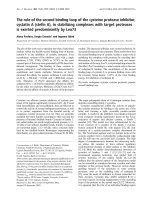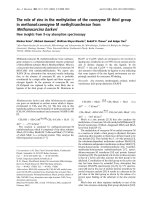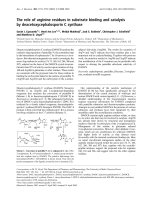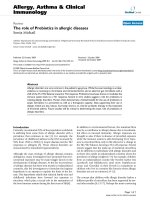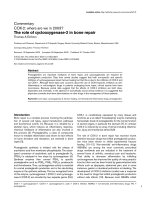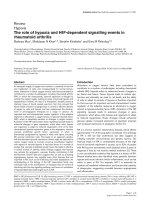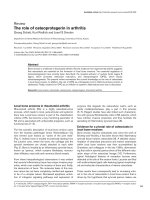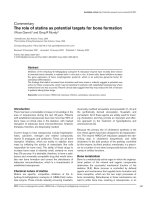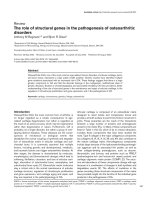Báo cáo y học: "The role of regulatory T cells in antigen-induced arthritis: aggravation of arthritis after depletion and amelioration after transfer of CD4+CD25+ T cells" doc
Bạn đang xem bản rút gọn của tài liệu. Xem và tải ngay bản đầy đủ của tài liệu tại đây (917.84 KB, 11 trang )
Available online />
Research article
Open Access
Vol 7 No 2
The role of regulatory T cells in antigen-induced arthritis:
aggravation of arthritis after depletion and amelioration after
transfer of CD4+CD25+ T cells
Oliver Frey1, Peter K Petrow1, Mieczyslaw Gajda1, Kerstin Siegmund2, Jochen Huehn2,
Alexander Scheffold3, Alf Hamann2, Andreas Radbruch3 and Rolf Bräuer1
1Institut
fur Pathologie, Friedrich-Schiller-Universität, Jena, Germany
Rheumatologie, Medizinische Klinik, Charité, Humboldt-Universität, c/o Deutsches Rheuma-Forschungszentrum, Berlin, Germany
3Deutsches Rheuma-Forschungszentrum, Berlin, Germany
2Experimentelle
Corresponding author: Rolf Bräuer,
Received: 1 Nov 2004 Revisions requested: 17 Nov 2004 Revisions received: 18 Nov 2004 Accepted: 24 Nov 2004 Published: 11 Jan 2005
Arthritis Res Ther 2005, 7:R291-R301 (DOI 10.1186/ar1484)
© 2005 Frey et al., licensee BioMed Central Ltd.
This is an Open Access article distributed under the terms of the Creative Commons Attribution License ( />2.0), which permits unrestricted use, distribution, and reproduction in any medium, provided the original work is cited.
/>
Abstract
It is now generally accepted that CD4+CD25+ Treg cells play a
major role in the prevention of autoimmunity and pathological
immune responses. Their involvement in the pathogenesis of
chronic arthritis is controversial, however, and so we examined
their role in experimental antigen-induced arthritis in mice.
Depletion of CD25-expressing cells in immunized animals
before arthritis induction led to increased cellular and humoral
immune responses to the inducing antigen (methylated bovine
serum albumin; mBSA) and autoantigens, and to an
exacerbation of arthritis, as indicated by clinical (knee joint
swelling) and histological scores. Transfer of CD4+CD25+ cells
into immunized mice at the time of induction of antigen-induced
arthritis decreased the severity of disease but was not able to
cure established arthritis. No significant changes in mBSAspecific immune responses were detected. In vivo migration
studies showed a preferential accumulation of CD4+CD25+
cells in the inflamed joint as compared with CD4+CD25- cells.
These data imply a significant role for CD4+CD25+ Treg cells in
the control of chronic arthritis. However, transferred Treg cells
appear to be unable to counteract established acute or chronic
inflammation. This is of considerable importance for the timing of
Treg cell transfer in potential therapeutic applications.
Keywords: arthritis, regulatory T cells
Introduction
Rheumatoid arthritis (RA) is the most common autoimmune
disease in humans, affecting 1% of the population in western countries. Histologically, RA is characterized by hyperplasia and infiltration of the synovial membrane with
mononuclear cells, development of an aggressive tissue
called pannus and secretion of proteases, which are
responsible for the destruction of articular cartilage and
adjacent bone. It is well established that macrophages and
synovial fibroblasts are effector cells of joint destruction,
and it is presumed that autoreactive CD4+ T cells are
involved in their activation [1]. There is now a large body of
evidence that, in rodents, regulatory T cells (Treg) actively
control the activation of autoreactive T cells and thus main-
tain immunological self-tolerance. Apart from adaptive Treg
cells, which can be induced by antigen-specific stimulation
of conventional peripheral T cells under tolerogenic conditions (for review [2]), there is no doubt that naturally occurring Treg cells exist in healthy mice as well as in humans and
rats, and these are characterized by constitutive expression
of CD25 [3-5]. Absence of these cells in vivo results in a
multi-organ autoimmune syndrome [3,6]. These
CD4+CD25+ Treg cells leave the thymus as committed 'professional' suppressor T cells [7-9], proliferate in the periphery, and acquire an effector/memory-like phenotype [10]. In
unmanipulated mice, Treg cells can also be found in the
CD25- compartment, based on the expression of the
AIA = antigen-induced arthritis; CFSE = 5,6-carboxyfluorescein diacetate succinimidyl ester; DTH = delayed-type hypersensitivity; ELISA = enzymelinked immunosorbent assay; FACS = fluorescence-activated cell sorting; FCS = fetal calf serum; IFN = interferon; IL = interleukin; mBSA = methylated bovine serum albumin; PBS = phosphate-buffered saline; RA = rheumatoid arthritis; SCID = severe combined immunodeficient; Treg = regulatory
T cell.
R291
Arthritis Research & Therapy
Vol 7 No 2
Frey et al.
integrin αEβ7 [10,11], possibly reflecting differences in
developmental stages of these cells.
The exact role played by naturally occurring CD4+CD25+
Treg cells in the pathogenesis of arthritis remains controversial. Arthritis is part of the autoimmune syndrome induced
by transfer of CD25-depleted splenocytes into lymphopenic hosts [3], and CD4+CD25+ cells are protective in
collagen-induced arthritis [12]. However, Bardos and coworkers [13] ruled out a role for naturally occurring
CD4+CD25+ Treg cells in proteoglycan-induced arthritis.
To clarify this issue, we used the antigen-induced arthritis
(AIA) model. AIA is a Tcell-dependent experimental arthritis
that is induced by intra-articular injection of antigen (methylated bovine serum albumin [mBSA]) into knee joints of
preimmunized mice [14,15]. This results in an acute inflammatory reaction, which is characterized by exudation of
neutrophils and fibrin, which later proceeds to a chronic
arthritis with synovial hyperplasia, infiltration of mononuclear cells, and cartilage and bone destruction – histopathological changes similar to those that occur in RA.
Autoimmune responses against cartilage constituents such
as collagen types I and II and proteoglycans are involved in
rendering the disease chronic [16,17]. Beyond the 100%
incidence of arthritis, another major advantage of the AIA
model is that the time point of induction of arthritis is
known, allowing manipulation of CD4+CD25+ Treg cell
number in vivo at defined stages in the disease. Using
depletion of CD25-expressing cells or transfer of
CD4+CD25+ cells, in the present study we demonstrated
that Treg cells modulate the onset of AIA but are ineffective
at later stages, calling into question their value as a new
therapeutic approach to established chronic arthritis.
Methods
Animals, arthritis induction and assessment
For all animal experiments, female C57Bl/6 mice (Charles
River, Sulzfeld, Germany; age range 6–10 weeks) were
used. Animals were kept under standard conditions, fed a
standard diet and given free access to water. All animal
studies were approved by the government commission for
animal protection.
At 21 and 14 days before arthritis induction, mice were
subcutaneously injected with 100 µg mBSA (Sigma,
Deisenhofen, Germany), emulsified in complete Freund's
adjuvant (Sigma) supplemented to 2 mg/ml heat-killed
Mycobacterium tuberculosis (strain H37RA; Becton Dickinson [BD], Heidelberg, Germany). Simultaneously, mice
received 5 × 108 heat-inactivated Bordetella pertussis
(Chiron-Behring, Marburg, Germany) intraperitoneally.
Arthritis was induced by intra-articular injection of 100 µg
mBSA in 25 µl phosphate-buffered saline (PBS) into the
right knee joint cavity.
R292
Arthritis severity was monitored by measurement of lateral
joint diameter using a vernier caliper (Oditest, Kroeplin Längenmesstechnik, Schlüchtern, Germany). Histological
severity of arthritis was scored in a blinded manner by two
investigators (PKP and MG) in frontal knee joint sections,
stained with haematoxylin and eosin and prepared as
described previously [14]. Briefly, at least four sections per
knee joint were semiquantitatively examined on a 0–3 point
scale for each of the following: extent of synovial hyperplasia, mononuclear infiltration, cartilage destruction and pannus formation.
Antibodies and reagents
The following antibodies were grown and purified from the
culture supernatants in our laboratory: anti-CD25 (PC61),
anti-CD3 (145 2C11), anti-CD4-FITC and FITC-labelled
anti-CD4-F(ab) (GK1.5), anti-CD8 (TIB105), anti-CD28
(37.51) and anti-Mac-1 (M1/70). The following antibodies
and secondary reagents were purchased from BD
Pharmingen (Heidelberg, Germany): PE-Cy5-labelled antiCD4 (H129.9), biotinylated anti-αEβ7 (M290), biotinylated
anti-CD25 (7D4), allophycocyanine or FITC-conjugated
anti-CD25 (PC61), streptavidin-allophycocyanine and
streptavidin-PE, and matched antibody pairs for ELISPOT
analysis of IFN-γ (R4-6A2 and biotinylated XMG1.2) and IL4 (BVD4 1D11 and biotinylated BVD6-24G2) production.
In vivo depletion
Mice were injected with 0.5 mg purified anti-CD25 antibody (PC61) 4 and 2 days before intra-articular antigen
injection. Polyclonal rat IgG, purified from normal rat serum,
was used as control. The degree of depletion was determined by fluorescence-activated cell sorting, using a noncross-reactive biotin-labelled anti-CD25, FITC-labelled
anti-CD4 and streptavidin-conjugated allophycocyanine.
Measurement was performed using FACSCalibur® (BD)
and data were analyzed using WinMDI http://
www.scripps.edu.
Preparation, pre-activation and transfer of regulatory T
cells
Pooled spleen and lymph node cells from naive C57Bl/6
donors or, if indicated, from immunized mice were incubated with anti-CD4-FITC (clone GK1.5) and anti-CD25biotin (clone 7D4; BD). CD4+ T cells were isolated using
an anti-FITC-Multisort-Kit (Miltenyi Biotech, Bergisch-Gladbach, Germany) in accordance with the manufacturer's
instructions. CD4+ T cells were sorted into CD25- and
CD25+ cells using anti-biotin MicroBeads (Miltenyi Biotech). Purity was greater than 92% for CD4+CD25- and
greater than 80% for CD4+CD25+ cells.
CD25-expressing and αEβ7-expressing subsets were
sorted by FACS. Briefly, pooled spleen and lymph node
cells from naive mice were stained with anti-CD25-FITC,
Available online />
anti-αEβ7-biotin and streptavidin-PE. The stained cells were
enriched with anti-FITC and anti-PE MicroBeads, using the
AutoMACS separation unit (Miltenyi Biotech). Thereafter,
the cells were sorted into subsets according to their
expression of CD25 or αEβ7 using a FACSDiVa cell sorter
(BD). The purity was 90–95%, as determined by FACS.
For activation, cells were cultured for 24–72 hours in the
presence of plate-bound anti-CD3 (3 µg/ml), anti-CD28
(10 µg/ml) and rhIL-2 (100 U/ml; Chiron, Ratingen, Germany) in RPMI 1640 containing 10% fetal calf serum (FCS;
Gibco, Karlsruhe, Germany). Thereafter, cells were washed
with PBS and transferred intravenously via lateral tail vein
into mice at the time point of AIA induction or at later time
points when indicated.
Delayed-type hypersensitivity reaction
Seven days after arthritis induction, mice were challenged
by intradermal injection into their ears of 5 µg mBSA in 10
µl PBS. Ear thickness was measured before injection and
24 and 48 hours later using a vernier caliper (Kroeplin).
Proliferation assay and ELISPOT analysis
Single cell suspension from spleens and lymph nodes
(inguinal, popliteal, axillary) were cultured at a density of 1
× 106/ml in RPMI 1640, containing 10% FCS, 2 mmol/l Lglutamine, 10 mmol/l Hepes, 1 mmol/l sodium pyruvate,
0.5 µmol/l 2-mercaptoethanol and antibiotics (100 U/ml
penicillin, 0.1 mg/ml streptomycin; all from Gibco) in the
presence of medium alone or 25 µg/ml mBSA for 72 hours
in 96-well tissue culture plates (Greiner Bio One, Nürtingen, Germany). Cells were pulsed with 0.5 µCi [3H]thymidine (Amersham-Buchler, Braunschweig, Germany) for the
last 18 hours of culture. Thereafter, cells were harvested
onto 96-well glass fibre filters (Packard Bioscience, Groningen, The Netherlands), and [3H]thymidine incorporation
was measured with a scintillation counter (Top-Count;
Packard Bioscience).
For ELISPOT analysis, PVDF-membrane 96-well microplates (Millipore, Eschborn, Germany) were coated overnight at 4°C with the primary antibody diluted in sterile
PBS. After washing, plates were blocked for 2 hours with
RPMI 1640 containing 10% FCS. Thereafter 2 × 105 (IL-2
and IFN-γ) or 1 × 106 (IL-4) cells were cultured in duplicate
wells for 24 (IL-2 and IFN-γ) or 48 hours (IL-4). After washing again plates were incubated overnight at 4°C with the
secondary antibody diluted in PBS/1% BSA. Extravidin–
alkaline phosphatase conjugate (1:30,000 in PBS/1%
BSA) and BCIP/NBT solution (bromochloroindolyle
phophate/nitroblue tetrazolium; both from Sigma) were
used for spot development. The number of spots was quantified using a KS-ELISPOT-Reader (Carl Zeiss, Oberkochen, Germany).
Determination of serum IgG by ELISA
Microplates (96-well; Greiner Bio One) were coated with
antigen (0.125 µg/ml mBSA), collagen type I (from rat tail
tendon) and type II (10 µg/ml), and proteoglycans (10 µg/
ml both from bovine cartilage) and left overnight, as
described previously [14]. After washing, plates were incubated with serially diluted serum samples and the amount
of bound IgG was determined using anti-mouse IgG-peroxidase conjugate (ICN, Eschwege, Germany) and orthophenylendiamine (Sigma) as substrate. Extinction was
measured at 492 nm against 620 nm with an ELISA reader
(Tecan, Crailsheim, Germany).
Cell transfer for in vivo homing assay
For in vivo homing assay, cells were sorted with a modified
protocol and labelled with 111indium, as described elsewhere [10]. Briefly, CD4+ cells were enriched by negative
selection. Enriched CD4+ T cells were stained with FITCconjugated anti-CD4-F(ab) and anti-CD25-allophycocyanine and sorted into CD4+CD25+ or CD4+CD25- cells by
FACS (BD). Cells were labelled with 111In (Indiumoxin;
Amersham-Buchler) for 20 min at room temperature; 1 ×
106 labeled cells were injected intravenously, and 24 hours
later mice were killed and the distribution of radioactivity in
various organs and the rest of the body was measured in a
γ-counter (Wallac Counter, Turku, Finnland).
Alternatively, a proportion of these cells was labelled with
5,6-carboxyfluorescein diacetate succinimidyl ester
(CFSE) by incubation with 5 µmol/l CFSE (Molecular
Probes, Leiden, The Netherlands) in RPMI 1640 for 5 min
at room temperature. After washing, 1 × 106 cells were
injected intravenously. Twenty-four hours later single cell
suspensions were prepared from the draining and nondraining peripheral and mesenteric lymph nodes, the spleen
and the peripheral blood, and stained with anti-CD4 and
analyzed by FACS. Dead cells were excluded using
propidiumiodide.
Statistical analysis
Data are expressed as mean ± standard error of mean,
unless otherwise indicated. Experimental groups were
tested for statistically significant differences with the
Mann–Whitney U-test using SPSS 10.0 (SPSS Inc, Chicago, IL, USA).
Results
Depletion of CD25-expressing cells exacerbates antigeninduced arthritis
Mice were injected intraperitoneally with 0.5 mg anti-CD25
(PC61) 4 and 2 days before induction of arthritis (i.e. 19
and 17 days after first immunization). Depletion of CD25expressing cells was confirmed using FACS at the time of
AIA induction (day 0) using an antibody that recognizes a
different epitope on the CD25 molecule. In the PC61R293
Arthritis Research & Therapy
Vol 7 No 2
Frey et al.
Figure 1
Depletion of CD25-expressing cells by anti-CD25 treatment Mice
treatment.
immunized with methylated bovine serum albumin (mBSA) were
injected intraperitoneally with 0.5 mg PC61 (anti-CD25) or rat IgG as
control 4 and 2 days before arthritis induction. Representative example
for flow-cytometric assessment of depletion in spleen cells, using a
non-cross-reactive anti-CD25 antibody (7D4) at the time of arthritis
induction (day 0).
treated group there was a 70.9 ± 11.4% (n = 3) reduction
in CD4+CD25+ cells in the spleens as compared with control mice injected with rat IgG (Fig. 1). Of note, the antiCD25 treatment almost completely depleted cells with high
expression of CD25, which are considered Treg cells, in
contrast to CD4+ T cells with low or intermediate levels of
CD25 expression.
mBSA, and analyzed for proliferative response and
cytokine production. As expected from the increased DTH
reaction, the proliferative response to mBSA was significantly increased in cells from CD25-depleted mice as compared with that in rat IgG-treated controls (Fig. 3b).
Importantly, even without antigenic stimulation the lymph
node cells from CD25-depleted mice proliferated fourfold
as much as cells from mice treated with control IgG. These
data imply that a substantial proportion of the T-cell compartment is still activated 14 days after intra-articular antigen challenge in the absence of Treg cells.
Compatible with these findings is that the production of
cytokines in response to mBSA was greater in CD25depleted mice. Importantly, both T-helper-1 (IFN-γ) and Thelper-2 (IL-4) responses were aggravated by depletion of
Treg cells, indicating that both types of response are subject
to suppression by Treg cells (Fig. 3c). Again, cytokine secretion from Treg-depleted animals was increased even without
antigenic stimulus. In accordance with this, serum levels of
IgG directed against mBSA as well as levels of the cartilage-specific autoantigens collagen type I, collagen type II
and proteoglycans, were found to be increased in CD25depleted mice (Fig. 3d).
Taken together, these data clearly demonstrate that
CD4+CD25+ Treg cells regulate the severity of arthritis by
limiting the cellular and humoral immune responses against
the inducing antigen mBSA as well as some arthritisrelated autoantigens.
Transfer of CD4+CD25+ cells
After intra-articular antigen injection, knee joint swelling of
the CD25-depleted mice was significantly greater from day
3 onward than in the control group injected with rat IgG
(Fig. 2a). Histological examination of knee joint sections 14
days after AIA induction revealed increased hyperplasia
and infiltration of the synovial membrane, as well as
increased articular damage in those animals (Fig. 2b–d). In
summary, this indicates a marked exacerbation of AIA by
depletion of CD25-expressing cells.
Increased cellular and humoral immune responsiveness
in CD25-depleted mice
To assess how in vivo cellular immune responses against
mBSA are influenced by depletion of CD25-expressing
cells, delayed-type hypersensitivity (DTH) reaction against
the same antigen was tested by intradermal injection of
mBSA into the ears of mice at day 7 after induction of AIA.
Anti-CD25 treated mice mounted a significantly stronger
DTH response than did rat IgG-treated controls (Fig. 3a).
For analysis of the cellular immune responses ex vivo,
draining lymph node cells of arthritic animals were harvested 14 days after AIA induction, restimulated with
R294
To further characterize the suppressive potential of
CD4+CD25+ Treg cells, we performed cell transfer studies.
In a first set of experiments we transferred Treg cells freshly
isolated from naive (Fig. 4a) or mBSA/CFA immunized (Fig.
4b) mice into mBSA-immunized recipients at the time of
intra-articular antigen challenge (day 0). With this protocol,
a slight decrease in the severity of clinical arthritis (knee
joint swelling) could be induced. Accordingly, the histological severity of AIA was also found to be reduced, albeit not
statistically significantly (Fig. 4a, b).
It is known that Treg cells must be activated via their T-cell
receptor to exert their suppressive function. Because we
were unable to use antigen-specific (i.e. T-cell receptor
transgenic) Treg cells, we opted to pre-activate the
CD4+CD25+ cells by in vitro culture in the presence of antiCD3, anti-CD28 and IL-2 in order to increase their suppressive potential. Transfer of 1 × 106 pre-activated cells
significantly suppressed both knee joint swelling and histological arthritis score (Fig. 4c). This effective suppression of
AIA development was a consistent finding in different
experiments, even with the use of lower cell numbers (for
instance 2 × 105 cells; data not shown).
Available online />
Figure 2
Clinical and histological severity of antigen-induced arthritis (AIA) in CD25-depleted mice (a) Knee joint swelling (difference in mediolateral joint
mice.
diameters of arthritic minus nonarthritic knee joints) during the time course of arthritis was higher in CD25-depleted mice. (b) Haematoxylin and
eosin stained frontal knee joint sections were scored on a 0–3 point scale at day 14 of AIA for each of the following: severity of synovial hyperplasia,
cellular infiltration, cartilage destruction and pannus formation. A score for inflammatory changes (Inf) was calculated by adding the points for synovial hyperplasia and infiltration, and for joint destruction (Dest) by adding the points for cartilage damage and pannus formation. Total arthritis score
(Score) was calculated by adding scores for inflammatory changes and joint destruction, giving a maximal AIA score of 12 points. Representative
photomicrographs of (c) a control (rat IgG-injected) and (d) a knee joint from an anti-CD25-treated mouse. Ten animals were included in each group
in two independent experiments. *P < 0.05, **P < 0.01, ***P < 0.001, versus control.
In the next step, we attempted to cure established arthritis
by transfer of Treg cells. Surprisingly, 1 × 106 pre-activated
CD4+CD25+ cells had no influence on either knee joint
swelling or histological arthritis score when transferred at
day 1 (Fig. 5a) or day 7 (Fig. 5b) after induction of arthritis.
Also, the transfer of 1 × 106 pre-activated αEβ7-expressing
Treg cells, which are highly effective in preventing AIA [10],
had no effect on disease at this time point (Fig. 5c).
Taken together, our data demonstrate that Treg cells can
inhibit arthritis development when transferred at the time of
arthritis induction. However, we were unable to demonstrate any therapeutic effect of Treg cell transfer (in numbers
that are effective in prevention) when performed after disease onset.
Transferred CD4+CD25+ Treg cells do not suppress
humoral or cellular immune responses
Because CD25-depletion caused a substantial increase in
both cellular and humoral immunoreactivity against mBSA,
we examined whether transfer of CD4+CD25+ Treg cells
can suppress these responses. Neither DTH reactivity
against mBSA (analyzed 7 days after AIA induction; Fig.
6a) nor mBSA-induced proliferation (Fig. 6b) and cytokine
production by draining lymph node cells (Fig. 6c) at day 14
after induction of AIA were found to be suppressed in the
recipients of 1 × 106 pre-activated CD4+CD25+ cells.
Thus, transfer of Treg cells into immunized animals does not
eliminate or induce functional modification to the previously
primed mBSA-specific immune response. In contrast,
transfer of CD4+CD25- cells did significantly enhance the
proliferation as well as the cytokine production in the recipients. Accordingly, serum levels of IgG directed against
mBSA and the cartilage-specific autoantigens collagen
type I and type II, and proteoglycans were also not
R295
Arthritis Research & Therapy
Vol 7 No 2
Frey et al.
Figure 3
Analysis of in vivo and ex vivo immune responses in CD25-depleted
mice
mice. (a) In vivo delayed-type hypersensitivity (DTH) response against
methylated bovine serum albumin (mBSA) as a marker for cellular
immune response was measured as the increase in ear thickness after
intradermal antigen challenge on day 7 of antigen-induced arthritis
(AIA). (b) Proliferation, measured as [3H]thymidine incorporation of
unstimulated (unst) or mBSA-stimulated (mBSA) draining lymph node
cells at day 14 of AIA. (c) Cytokine production was measured with
ELISPOT. (d) Serum levels of IgG against mBSA, collagen type I, collagen type II and cartilage proteoglycans were measured using ELISA
after 14 days of AIA. Proliferation, DTH reaction and serum IgG titres
were tested in 10 animals per group; cytokine production was measured in six animals per group. Data are from one out of two similar
experiments. *P < 0.05, **P < 0.01, ***P < 0.001, versus control.
significantly diminished in Treg cell recipients compared
with the saline-treated control group. Recipients of
CD4+CD25- cells had higher levels of IgGs (Fig. 6d).
R296
Figure 4
Modulation of antigen-induced arthritis (AIA) by transfer of regulatory T
cells (Treg cells)
cells (Treg cells). Amelioration of clinical and histological severity of AIA
by transfer of 2 × 106 CD4+CD25+ cells freshly isolated from (a) naive
or (b) immunized mice at the time of AIA induction (day 0; n = 6 per
group). (c) Transfer of 1 × 106 in vitro pre-activated cells at the time of
AIA induction (n = 6). #P < 0.05, ##P < 0.01 for CD4+CD25+ versus
CD4+CD25-; +P < 0.05, ++P < 0.01 for CD4+CD25+ versus phosphate-buffered saline. Dest, joint destruction; Inf, inflammatory changes;
Score; total arthritis score
Homing properties of CD4+CD25+ Treg cells
Because the mechanism of suppression of Treg cells in vitro
is cell contact dependent, localization of cells might be
important for their regulatory activity. Therefore, we
investigated the migration behaviour of CD4+CD25+ and
CD4+CD25- cells in vivo. For these experiments CD4+
cells were enriched by negative selection and sorted by
FACS into CD4+CD25+ and CD4+CD25- populations with
preferential use of F(ab)-fragments or antibodies, which do
not interfere with migration in vivo. Cells were labelled with
111In and injected intravenously into AIA mice 7 days after
Available online />
Figure 5
Transfer of regulatory T cells (Treg cells) cannot cure established arthriarthritis
tis. Pre-activated CD4+CD25+ cells (1 × 106) were transferred on (a)
day 1 or (b) day 7 of antigen-induced arthritis (AIA). Arthritis severity
was monitored by measurement of knee joint swelling and by histological assessment 14 days after cell transfer (n = 6–7 per group). (c)
Also, 1 × 106 pre-activated αEβ7-expressing Treg cells have no curative
effect in AIA (n = 8 per group).
induction of arthritis. After 24 hours radioactivity was measured in different organs.
Compared with CD4+CD25- cells, CD4+CD25+ Treg cells
were less abundant in secondary lymphoid organs such as
lymph nodes and spleen. Thus, CD4+CD25+ cells recirculate through these organs less than do CD4+CD25- cells.
In the liver, more radioactivity was recovered in recipients
of CD4+CD25+ cells as compared with CD4+CD25- cells.
Figure 6
There is (mBSA)-specificof cellular or humoral methylated bovine serum
albumin no suppression immunity with transfer of Treg cells
albumin (mBSA)-specific immunity with transfer of Treg cells. Pre-activated CD4+CD25+ cells (1 × 106) were transferred at the time of antigen-induced arthritis (AIA) induction. (a) Delayed-type hypersensitivity
(DTH) reactivity against mBSA in vivo was tested 7 days later by an
intradermal antigen challenge into the ears. (b) Antigen-specific proliferation ([3H]thymidine incorporation) and (c) cytokine production (ELISPOT) of draining lymph node cells was measured 14 days after AIA
induction. (d) Serum levels of IgG against mBSA, collagen type I, collagen type II and cartilage proteoglycans were measured with ELISA after
14 days of AIA. Proliferation, DTH reaction, cytokine production, and
serum IgG titres were tested in six animals per group. #P < 0.05 for
CD4+CD25+ versus CD4+CD25-; *P < 0.05 for CD4+CD25- versus
phosphate-buffered saline.
Importantly, CD4+CD25+ cells also had a significantly better capacity to enter the inflamed joint than did CD4+CD25cells (Fig. 7a). The level of radioactivity detected in the
arthritic joints was low but similar to levels found in transfer
experiments with effector T cells [18]. As a control, some
mice were injected with CFSE-labelled cells. FACS analysis of the secondary lymphoid organs revealed the presence of viable cells 24 hours after transfer and excluded the
R297
Arthritis Research & Therapy
Vol 7 No 2
Frey et al.
Figure 7
Migration behaviour of regulatory T cells (Treg cells) (a) CD4+CD25+
cells).
and CD4+CD25- cells were purified by fluorescence-activated cell sorting (FACS) and labelled with 111In. Cells (1 × 106) were injected intravenously into antigen-induced arthritis (AIA) mice at day 7. After 24
hours radioactivity in isolated organs and the rest of the body was
determined using a γ-counter. Thereafter, the total radioactivity recovered per animal was calculated by adding the counts of the organs and
the rest of the body. (a) The proportion of radioactivity found in the isolated organs is shown here as a percentage of total recovered radioactivity (n = 6; mean ± standard error of the mean; one representative out
of two independent experiments; **P < 0.01). (b) FACS-purified cells
were labelled with 5,6-carboxyfluorescein diacetate succinimidyl ester
(CFSE) and injected intravenously. After 24 hours single-cell suspensions from draining lymph node (dLN), nondraining peripheral lymph
node (pLN), mesenteric lymph node (mLN), spleen and peripheral
blood lymphocytes (PBL) were analyzed by FACS. The percentage of
CFSE+ cells of the total CD4+ cells was measured. Histogram plots are
gated on CD4+ cells after propidium–iodide exclusion of dead cells (n
= 3 per group). Higher numbers of CFSEhigh cells are found in the secondary lymphoid organs in the recipients of CD4+CD25- cells.
possibility that the difference in migration pattern is due to
leakage of radioactivity (Fig. 7b). The migration behaviour
of CD4+CD25+ Treg cells does reflect their more activated
phenotype, and their ability to enter inflamed joints makes it
possible that they act directly at the site of inflammation.
Discussion
Our findings provide clear evidence that CD4+CD25+ Treg
cells are critical for regulating the severity of AIA in mice.
We showed this by manipulating the Treg cell numbers
using two different approaches: depletion of CD25R298
expressing cells and transfer of purified CD4+CD25+ Treg
cells. It is important to stress that we depleted CD25expressing cells in the interval between immunization and
AIA induction, because CD25-depletion before immunization profoundly increases the resulting humoral and cellular
immune responses [3,12]. These data are consistent with
studies conducted in collagen-induced arthritis; however,
in these experiments CD25-expressing cells were depleted
before immunization with collagen type II, and the resulting
more severe arthritis could be interpreted as the result of
stronger immunization state [12]. With our experimental
design, we were able to examine the effect of Treg cells in
ongoing joint inflammation directly. Because CD25 is also
expressed on activated conventional T cells, it could be
assumed that injection of an anti-CD25 antibody would
deplete not only Treg cells but also effector T cells, but the
exacerbated AIA in CD25-depleted mice argues against
such a depletion of effector T cells. Accordingly, in control
experiments lymph node cells from CD25-depleted mice
isolated at the time of induction of AIA were able to mount
a similar anti-mBSA response in vitro as compared with
control mice (data not shown). Furthermore, CD4+CD25+
cells isolated from immunized donors can suppress development of AIA (Fig. 4b). Taken together, these data imply
that the CD25+ compartment in immunized mice largely
consists of Treg cells.
AIA induction in CD25-depleted mice resulted in a much
more severe arthritis in the acute and chronic stages of disease. We recently showed, with the use of a depleting antiCD4 antibody, that this acute stage of AIA is already under
the control of T cells [15]. Nevertheless, early AIA is dominated by cells of the innate immune system [19], and the
exacerbation of arthritis in CD25-depleted mice could be
due to a lack of suppression of these cells by Treg cells. In
accordance with this view, CD4+CD25+ Treg cells are able
to suppress innate immune cells in a model of bacteriainduced colitis [20].
In later stages exacerbated arthritis in CD25-depleted mice
is accompanied by increased mBSA-specific proliferation
and IgG production. This enhanced responsiveness
emerged during arthritis development and is due to sustained T cell activation. Such prolonged T cell activation in
the absence of CD4+CD25+ cells has also been described
in other disease models [21] and is probably the cause of
the increased AIA severity. Moreover, the PC61 antibody
used in our study has a half-life of approximately 3 weeks in
vivo (Sutmuller R, personal communication), which makes
it possible that Treg cell function is not only impaired by
depletion but also by blockade of IL-2 binding to CD25 by
the PC61 antibody. IL-2 or IL-2 signalling via CD25 has
been shown to be critical to the regulatory action of Treg
cells [22,23]. Also, activation-induced cell death of pathogenic T cells, which is regulated by IL-2, could be impaired
Available online />
by withdrawal of IL-2 signalling and therefore contribute to
the observed high levels of cellular immune responses in
our study [24].
How this effect is mediated is unclear but an involvement of
IL-10 or transforming growth factor-β is possible
[20,35,36].
The fact that depletion of CD4+CD25+ Treg cells enhances
the immune response against the foreign antigen mBSA
clearly demonstrates that their suppressive effect is not
strictly limited to autoreactive T cells. Taking into consideration that Treg cells are also critically involved in the control
of immune responses against pathogens [25,26], their
physiological function is not just to prevent autoimmunity
but also to control the extent of inflammatory reactions in
order to prevent tissue damage to the host. Further support
for the influence of CD4+CD25+ Treg cells on arthritis development came from the transfer experiments. When transferred at the time of induction of AIA, CD4+CD25+ cells
were able to ameliorate ongoing disease. Analysis of the
recipients did not reveal a remarkable long-lasting suppression of systemic mBSA-specific immune reactions. Thus,
prevention of AIA appears to be possible without inducing
anergy or abrogating previously induced T-cell effector
functions [27]. In contrast to this, transferred CD4+CD25cells significantly enhance cell-mediated and humoral
immune responses.
If these hypotheses are correct, then they could explain
why the transfer of Treg cells after arthritis induction is not
effective. On the one hand, transfer of Treg cells 24 hours
after intra-articular antigen challenge might be too late to
inhibit activation of effector T cells and their migration to the
joint. Indeed, T-cell activation is an early event in AIA
because CD4+ T cell depletion ameliorates the acute stage
of the model [15]. On the other hand, it could be possible
that the suppressive function of regulatory T cells is
switched off under the inflammatory conditions present in
the inflamed tissue by factors such as IL-6 or
glucocorticoid-induced tumor necrosis factor family-related
gene (GITR) and GITR-ligand interactions, abrogating the
suppressive effect of Treg cells [37]. With this in mind, it
could be interesting to investigate whether the accumulated Treg cells in patients with arthritis function properly in
vivo and whether these patients could really benefit from a
therapeutic enhancement of Treg function, as suggested by
some enthusiastic investigators in this field.
Furthermore, the homing data presented here demonstrate
that CD4+CD25+ cells can migrate into the arthritic knee
joint. Functional Treg cells have repeatedly been found
within such effector sites and/or draining lymph nodes, for
instance in tolerated allografts [28], in Langerhans islets
and pancreatic lymph nodes in inflammation-induced diabetes [29], in chronically inflamed skin in a Leishmania
infection model [30], and in the mucosa and mesenteric
lymph nodes in inflammatory colitis in severe combined
immunodeficient (SCID) mice [31]. Interestingly, two
recent papers [32,33] reported an accumulation of functional Treg cells in the inflamed joints of patients with RA,
juvenile arthritis and other rheumatic diseases.
It is most likely that the transferred CD4+CD25+ Treg cells
act in the draining lymph node as well as in the inflamed tissue. Within such a scenario, it could be possible that Treg
cells inhibit the activation of effector T cells and their subsequent migration to the joints. Such a mechanism was
recently speculated in modulation of virally induced immunopathology by T cells [26].
Huehn and colleagues [11] recently demonstrated that
CD4+CD25+ Treg cells can be divided into subsets based
on the expression of the integrin αEβ7. Moreover, this
marker identifies CD25- Treg cells [34]. Both αEβ7-expressing subsets had better capacity to reach the inflamed joint
and to prevent arthritis in the AIA model, as compared with
αEβ7- Treg cells [10]. Thus, suppression at the site of inflammation is also an important part of the activity of Treg cells.
In this regard, data on the curative effects of Treg cells in
experimental disease models are conflicting. To best of our
knowledge, a curative effect of CD4+CD25+ Treg cells has
only been demonstrated in the colitis model induced by
transfer of CD45RBhigh T cells into SCID mice [31,38]. In
contrast, other authors were unable to demonstrate such
an inhibitory effect of Treg cells on SCID colitis when they
were transferred 1 week after administration of pathogenic
CD45RBhigh T cells [39]. Because arthritis in the AIA model
has a hyperacute onset, it could be assumed that the time
window for an ameliorative effect of Treg cell transfer ends
very shortly after intra-articular injection of antigen. However, further studies on the role of Treg cells in other arthritis
models are clearly needed to clarify whether enhancement
in Treg cell function might be beneficial in experimental
arthritis and perhaps in human disease.
Conclusion
Our data show that Treg cells are critically involved in the
control of immune responses that are responsible for the
pathogenesis of chronic arthritis. Transfer of such cells can
modulate the severity of ongoing inflammatory arthritis but
they cannot suppress established disease. Thus, timing of
Treg cell transfer for therapeutic purposes is of considerable
importance.
Competing interests
The author(s) declare that they have no competing
interests.
R299
Arthritis Research & Therapy
Vol 7 No 2
Frey et al.
Authors' contributions
OF purified the anti-CD25 hybridoma and purified the monoclonal antibodies from the supernatant; planned and conducted all animal experiments, including ELISA and
ELISPOT analysis; and drafted the manuscript. PKP and
MG scored the histological changes in arthritic joints. KS,
JH and AH conducted the migration experiments, as well as
the αEβ7 transfer experiments. RB supervised the project
and participated together with AS and AR in the design of
the study and its coordination, and helped to draft the manuscript. All authors read and approved the final manuscript.
13.
14.
15.
16.
Acknowledgments
We thank T Kaiser and K Raba for FACS sorting; M Schinz and A
Kaufmann for help with ELISPOT; H Börner, C Hüttich and R Stöckigt
for their excellent technical assistance; and KW Pratt and D Szczawinska for critical comments on the manuscript. This work was supported
by the Kompetenznetz Rheuma (Grant 01 GI 0344), Deutsche Forschungsgemeinschaft (Grant Br 1372/5-1) and the Interdisciplinary
Center for Clinical Research (IZKF) Jena.
17.
18.
19.
References
1.
Kinne RW, Palombo-Kinne E, Emmrich F: T-cells in the pathogenesis of rheumatoid arthritis villains or accomplices? Biochim Biophys Acta 1997, 1360:109-141.
2. Bluestone JA, Abbas AK: Natural versus adaptive regulatory T
cells. Nat Rev Immunol 2003, 3:253-257.
3. Sakaguchi S, Sakaguchi N, Asano M, Itoh M, Toda M: Immunologic self-tolerance maintained by activated T cells expressing
IL-2 receptor alpha-chains (CD25). Breakdown of a single
mechanism of self-tolerance causes various autoimmune
diseases. J Immunol 1995, 155:1151-1164.
4. Stephens LA, Mason D: CD25 is a marker for CD4+ thymocytes
that prevent autoimmune diabetes in rats, but peripheral T
cells with this function are found in both CD25+ and CD25subpopulations. J Immunol 2000, 165:3105-3110.
5. Baecher-Allan C, Brown JA, Freeman GJ, Hafler DA:
CD4+CD25high regulatory cells in human peripheral blood. J
Immunol 2001, 167:1245-1253.
6. Suri-Payer E, Amar AZ, Thornton AM, Shevach EM: CD4+CD25+ T
cells inhibit both the induction and effector function of autoreactive T cells and represent a unique lineage of immunoregulatory cells. J Immunol 1998, 160:1212-1218.
7. Itoh M, Takahashi T, Sakaguchi N, Kuniyasu Y, Shimizu J, Otsuka
F, Sakaguchi S: Thymus and autoimmunity: production of
CD25+CD4+ naturally anergic and suppressive T cells as a key
function of the thymus in maintaining immunologic self-tolerance. J Immunol 1999, 162:5317-5326.
8. Apostolou I, Sarukhan A, Klein L, von Boehmer H: Origin of regulatory T cells with known specificity for antigen. Nat Immunol
2002, 3:756-763.
9. Kawahata K, Misaki Y, Yamauchi M, Tsunekawa S, Setoguchi K,
Miyazaki J, Yamamoto K: Generation of CD4+CD25+ regulatory T
cells from autoreactive T cells simultaneously with their negative selection in the thymus and from nonautoreactive T cells
by endogenous TCR expression. J Immunol 2002,
168:4399-4405.
10. Huehn J, Siegmund K, Lehmann JC, Siewert C, Haubold U,
Feuerer M, Debes GF, Lauber J, Frey O, Przybylski GK, et al.:
Developmental stage, phenotype, and migration distinguish
naive- and effector/memory-like CD4+ regulatory T cells. J Exp
Med 2004, 199:303-313.
11. Lehmann J, Huehn J, de la Rosa M, Maszyna F, Kretschmer U,
Krenn V, Brunner M, Scheffold A, Hamann A: Expression of the
integrin alpha Ebeta 7 identifies unique subsets of CD25+ as
well as CD25- regulatory T cells. Proc Natl Acad Sci USA 2002,
99:13031-13036.
12. Morgan ME, Sutmuller RP, Witteveen HJ, van Duivenvoorde LM,
Zanelli E, Melief CJ, Snijders A, Offringa R, de Vries RR, Toes RE:
R300
20.
21.
22.
23.
24.
25.
26.
27.
28.
29.
30.
31.
32.
33.
CD25+ cell depletion hastens the onset of severe disease in
collagen-induced
arthritis.
Arthritis
Rheum
2003,
48:1452-1460.
Bardos T, Czipri M, Vermes C, Finnegan A, Mikecz K, Zhang J:
CD4+CD25+ immunoregulatory T cells may not be involved in
controlling autoimmune arthritis. Arthritis Res Ther 2003,
5:R106-R113.
Petrow PK, Thoss K, Katenkamp D, Bräuer R: Adoptive transfer
of susceptibility to antigen-induced arthritis into severe combined immunodeficient (SCID) mice: role of CD4+ and CD8+ T
cells. Immunol Invest 1996, 25:341-353.
Pohlers D, Nissler K, Frey O, Simon J, Petrow PK, Kinne RW,
Bräuer R: Anti-CD4 monoclonal antibody treatment in acute
and early chronic antigen-induced arthritis: influence on T
helper cell activation. Clin Exp Immunol 2004, 135:409-415.
Petrow PK, Thoss K, Henzgen S, Katenkamp D, Bräuer R: Limiting
dilution analysis of the frequency of autoreactive lymph node
cells isolated from mice with antigen-induced arthritis. J
Autoimmun 1996, 9:629-635.
Bräuer R, Kittlick PD, Thoss K, Henzgen S: Different immunological mechanisms contribute to cartilage destruction in antigeninduced arthritis. Exp Toxicol Pathol 1994, 46:383-388.
Austrup F, Vestweber D, Borges E, Lohning M, Bräuer R, Herz U,
Renz H, Hallmann R, Scheffold A, Radbruch A, Hamann A: P- and
E-selectin mediate recruitment of T-helper-1 but not T-helper2 cells into inflamed tissues. Nature 1997, 385:81-83.
Simon J, Surber R, Kleinstauber G, Petrow PK, Henzgen S, Kinne
RW, Brauer R: Systemic macrophage activation in locallyinduced experimental arthritis. J Autoimmun 2001, 17:127-136.
Maloy KJ, Salaun L, Cahill R, Dougan G, Saunders NJ, Powrie F:
CD4+CD25+ T(R) cells suppress innate immune pathology
through cytokine-dependent mechanisms. J Exp Med 2003,
197:111-119.
Suvas S, Kumaraguru U, Pack CD, Lee S, Rouse BT: CD4+CD25+
T cells regulate virus-specific primary and memory CD8+ T cell
responses. J Exp Med 2003, 198:889-901.
Almeida AR, Legrand N, Papiernik M, Freitas AA: Homeostasis of
peripheral CD4+ T cells: IL-2R alpha and IL-2 shape a population of regulatory cells that controls CD4+ T cell numbers. J
Immunol 2002, 169:4850-4860.
De La Rosa M, Rutz S, Dorninger H, Scheffold A: Interleukin-2 is
essential for CD4+CD25+ regulatory T cell function. Eur J
Immunol 2004, 34:2480-2488.
Lenardo MJ: Interleukin-2 programs mouse alpha beta T lymphocytes for apoptosis. Nature 1991, 353:858-861.
Hisaeda H, Maekawa Y, Iwakawa D, Okada H, Himeno K, Kishihara
K, Tsukumo S, Yasutomo K: Escape of malaria parasites from
host immunity requires CD4+CD25+ regulatory T cells. Nat Med
2004, 10:29-30.
Suvas S, Azkur AK, Kim BS, Kumaraguru U, Rouse BT:
CD4+CD25+ regulatory T cells control the severity of viral
immunoinflammatory
lesions.
J
Immunol
2004,
172:4123-4132.
Martin B, Banz A, Bienvenu B, Cordier C, Dautigny N, Becourt C,
Lucas B: Suppression of CD4+ T lymphocyte effector functions
by CD4+CD25+ cells in vivo. J Immunol 2004, 172:3391-3398.
Graca L, Cobbold SP, Waldmann H: Identification of regulatory
T cells in tolerated allografts. J Exp Med 2002, 195:1641-1646.
Green EA, Choi Y, Flavell RA: Pancreatic lymph node-derived
CD4+CD25+ Treg cells: highly potent regulators of diabetes
that require TRANCE-RANK signals. Immunity 2002,
16:183-191.
Belkaid Y, Piccirillo CA, Mendez S, Shevach EM, Sacks DL:
CD4+CD25+ regulatory T cells control Leishmania major persistence and immunity. Nature 2002, 420:502-507.
Mottet C, Uhlig HH, Powrie F: Cutting edge: cure of colitis by
Immunol 2003,
CD4+CD25+ regulatory T cells. J
170:3939-3943.
Cao D, Vollenhoven Rv R, Klareskog L, Trollmo C, Malmstrom V:
CD25brightCD4+ regulatory T cells are enriched in inflamed
joints of patients with chronic rheumatic disease. Arthritis Res
Ther 2004, 6:R335-R346.
de Kleer IM, Wedderburn LR, Taams LS, Patel A, Varsani H, Klein
M, de Jager W, Pugayung G, Giannoni F, Rijkers G, et al.:
CD4+CD25bright regulatory T cells actively regulate inflammation in the joints of patients with the remitting form of juvenile
idiopathic arthritis. J Immunol 2004, 172:6435-6443.
Available online />
34. Banz A, Peixoto A, Pontoux C, Cordier C, Rocha B, Papiernik M: A
unique subpopulation of CD4+ regulatory T cells controls
wasting disease, IL-10 secretion and T cell homeostasis. Eur J
Immunol 2003, 33:2419-2428.
35. Oida T, Zhang X, Goto M, Hachimura S, Totsuka M, Kaminogawa
S, Weiner HL: CD4+CD25- T cells that express latency-associated peptide on the surface suppress CD4+CD45RBhighinduced colitis by a TGF-beta-dependent mechanism. J
Immunol 2003, 170:2516-2522.
36. Green EA, Gorelik L, McGregor CM, Tran EH, Flavell RA:
CD4+CD25+ T regulatory cells control anti-islet CD8+ T cells
through TGF-beta–TGF-beta receptor interactions in type 1
diabetes. Proc Natl Acad Sci USA 2003, 100:10878-10883.
37. Pasare C, Medzhitov R: Toll pathway-dependent blockade of
CD4+CD25+ T cell-mediated suppression by dendritic cells.
Science 2003, 299:1033-1036.
38. Liu H, Hu B, Xu D, Liew FY: CD4+CD25+ regulatory T cells cure
murine colitis: the role of IL-10, TGF-beta, and CTLA4. J
Immunol 2003, 171:5012-5017.
39. Foussat A, Cottrez F, Brun V, Fournier N, Breittmayer J-P, Groux H:
A comparative study between T regulatory type 1 and
CD4+CD25+ T cells in the control of inflammation. J Immunol
2003, 171:5018-5026.
R301
